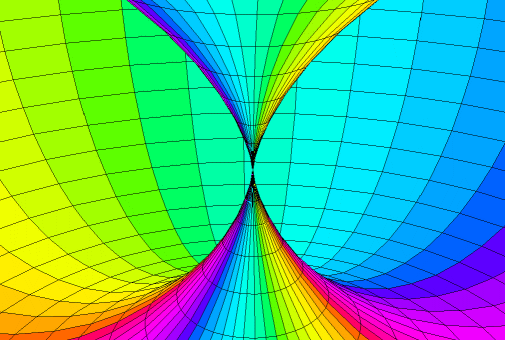![[Y00]](images/Yellm/Y00.jpg)
Y0,0
![[ReY11]](images/Yellm/ReY11.jpg)
Re(Y1,1)
![[Y10]](images/Yellm/Y10.jpg)
Y1,0
![[Y11]](images/Yellm/Y11.jpg)
Y1,1
![[ReY22]](images/Yellm/ReY22.jpg)
Re(Y2,2)
![[ReY21]](images/Yellm/ReY21.jpg)
Re(Y2,1)
![[Y20]](images/Yellm/Y20.jpg)
Y2,0
![[Y21]](images/Yellm/Y21.jpg)
Y2,1
![[Y22]](images/Yellm/Y22.jpg)
Y2,2
![[ReY33]](images/Yellm/ReY33.jpg)
Re(Y3,3)
![[ReY32]](images/Yellm/ReY32.jpg)
Re(Y3,2)
![[ReY31]](images/Yellm/ReY31.jpg)
Re(Y3,1)
![[Y30]](images/Yellm/Y30.jpg)
Y3,0
![[Y31]](images/Yellm/Y31.jpg)
Y3,1
![[Y32]](images/Yellm/Y32.jpg)
Y3,2
![[Y33]](images/Yellm/Y33.jpg)
Y3,3
The Spherical Harmonics, Yℓ,m(θ, φ), are functions defined on the sphere. They are used to describe the wave function of the electron in a hydrogen atom, oscillations of a soap bubble, etc. The spherical harmonics describe non-symmetric solutions to problems with spherical symmetry.
The Yℓ,m’s are complex valued. The radius of the figure is the magnitude, and the color shows the phase, of Yℓ,m(θ, φ). These are the numbers on the unit circle: 1 is red, i is purple, -1 is cyan (light blue), and -i is yellow-green.
For each value of ℓ, there are 2ℓ + 1 linearly independent functions Yℓ,m, where m = -ℓ, -ℓ+1, ... , ℓ-1, ℓ. I have chosen a different set of 2ℓ + 1 functions, as you see below.
![[Y00]](images/Yellm/Y00.jpg)
Y0,0 |
||||||
![[ReY11]](images/Yellm/ReY11.jpg)
Re(Y1,1) |
![[Y10]](images/Yellm/Y10.jpg)
Y1,0 |
![[Y11]](images/Yellm/Y11.jpg)
Y1,1 |
||||
![[ReY22]](images/Yellm/ReY22.jpg)
Re(Y2,2) |
![[ReY21]](images/Yellm/ReY21.jpg)
Re(Y2,1) |
![[Y20]](images/Yellm/Y20.jpg)
Y2,0 |
![[Y21]](images/Yellm/Y21.jpg)
Y2,1 |
![[Y22]](images/Yellm/Y22.jpg)
Y2,2 |
||
![[ReY33]](images/Yellm/ReY33.jpg)
Re(Y3,3) |
![[ReY32]](images/Yellm/ReY32.jpg)
Re(Y3,2) |
![[ReY31]](images/Yellm/ReY31.jpg)
Re(Y3,1) |
![[Y30]](images/Yellm/Y30.jpg)
Y3,0 |
![[Y31]](images/Yellm/Y31.jpg)
Y3,1 |
![[Y32]](images/Yellm/Y32.jpg)
Y3,2 |
![[Y33]](images/Yellm/Y33.jpg)
Y3,3 |
The following figure is called “inside Y2,2”. My son, Michael, made this by holding down the “Page Up” key until the viewpoint gets inside the surface. (He suggests that you set the figure rotating continuously, and move the viewpoint a bit down before zooming in.)

Oscillations of a Soap Bubble
The volume of the bubble is constant, so Y0,0 is not used. The center
of mass of the bubble is constant, so Y1,m is not used. The lowest
frequency oscillations of a soap bubble are ℓ = 2. The radius of the soap film
is
r = 1 + ε Y2,m
(θ, φ). The oscillations with different m all have the same frequency. The shape
of the oscillations with
m = 1
and
m = 2
are the same up to a rotation, but the
m = 0
oscillation is different.
Physics and Math notation
WARNING: Spherical coordinates are different in physics and mathematics. The
symbols θ and φ are switched! The math notation makes r and θ the same in
cylincrical and spherical coordinates. DPGraph uses math notation.
These graphs were produced by DPGraph, which is a fast program for viewing 3D objects.